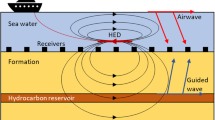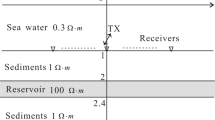Abstract
This paper presents a three-dimensional (3D) marine controlled-source electromagnetic modeling algorithm using primary fields for a homogeneous half-space to accurately account for airwave effects. This algorithm is validated with analytic solutions for 1D two- and four-layer models and numerical results from another 3D model. Using this code, we investigate the 3D electromagnetic responses of a 100 m thick, 5 km disk-shaped hydrocarbon reservoir buried at a depth of 1 km below the seafloor. From the numerical results, we can recognize that a 3D effect of the reservoir typically produces a transition zone in comparison with 1D model responses. The transition zone decreases with the airwave effect as the depth of water becomes shallow. As the source frequency increases, the sensitivity to the reservoir increases, whereas the amplitude decreases and falls at higher than 1 Hz below the current system noise floor. Broadside electric fields for a 10-km diameter disk model are only about 5% of in-line electric fields for the 5-km disk model. The Tequivalence is observed at such a low frequency of 1 Hz for the thin resistive tabular target, whose response varies almost linearly with the target thickness and resistivity even in the transition zone.
Similar content being viewed by others
References
Chave, A.D., Constable, S.C., and Edwards, R.N., 1991, Electrical exploration methods for the seafloor. In: Nabighian, M.N. (ed.), Electromagnetic Methods in Applied Geophysics, Vol. 2. Society of Exploration Geophysicists, 931–966.
Chave, A.D., 2009, On the electromagnetic fields produced by marine frequency domain controlled sources. Geophysical Journal International, 179, 1429–1457. doi: 10.1111/j.1365-246X.2009.04367.x
Constable, S. and Weiss, C.J., 2006, Mapping thin resistors and hydrocarbons with marine EM methods: Insights from 1D modeling. Geophysics, 71, G43–G51. doi: 10.1190/1.2187748
Constable, S. and Srnka, L.J., 2007, An introduction to marine controlled source electromagnetic methods for hydrocarbon exploration. Geophysics, 72, WA3–WA12. doi:10.1190/1.2432483
Constable, S., 2010, Ten years of marine CSEM for hydrocarbon exploration. Geophysics, 75, 75A67–75A81. doi: 10.1190/1.3483451
Eidesmo, T., Ellingsrud, S., MacGregor, L.M., Constable, S., Sinha, M.C., Johansen, S.E., Kong, F.N., and Westerdahl, H., 2002, Sea Bed Logging (SBL), a new method for remote and direct identification of hydrocarbon filled layers in deepwater areas. First Break, 20, 144–152. doi:10.1046/j.1365-2397.2002.00264.x
Frenkel, M.A. and Davydycheva, S., 2012, To CSEM or not to CSEM? Feasibility of 3D marine CSEM for detecting small targets. The Leading Edge, 31, 435–446. doi: 10.1190/tle31040435.1
Key, K., 2012, Marine electromagnetic studies of seafloor resources and tectonics. Surveys in geophysics, 33, 135–167. doi:10.1007/s10712-011-9139-x
Kong, F.N., 2007, Hankel transform filters for dipole antenna radiation in a conductive medium. Geophysical Prospecting, 55, 83–89. doi: 10.1111/j.1365-2478.2006.00585.x
Lee, K.H., Jang, H., Jang, H., and Kim, H.J., 2011, Sensitivity analysis of marine controlled-source electromagnetic methods to a shallow gas-hydrate layer with 1D forward modeling. Geosciences Journal, 15, 297–303. doi: 10.1007/s12303-011-0030-z
Mittet, R., 2010, High-order finite-difference simulations of marine CSEM surveys using a correspondence principle for wave and diffusion fields. Geophysics, 75, F33–F50. doi: 10.1190/1.3278525
Newman, G.A. and Alumbaugh, D.L., 1995, Frequency-domain modelling of airborne electromagnetic responses using staggered finite differences. Geophysical Prospecting, 43, 1021–1042. doi: 10.1111/j.1365-2478.1995.tb00294.x
Sasaki, Y. and Meju, M.A., 2009, Useful characteristics of shallow and deep marine CSEM responses inferred from 3D finite-difference modeling. Geophysics, 74, F67–F76. doi: 10.1190/1.3168616
Strack, K.M., 2014, Future directions of electromagnetic methods for hydrocarbon applications. Surveys in Geophysics, 35, 157–177. doi: 10.1007/s10712-013-9237-z
Tehrani, A.M. and Slob, E., 2013, Applicability of 1D and 2.5D marine controlled source electromagnetic modelling. Geophysical Prospecting, 61, 602–613. doi: 10.1111/1365-2478.12019
Um, E.S. and Alumbaugh, D.L., 2007, On the physics of the marine controlled source electromagnetic method. Geophysics, 72, WA13–WA26. doi:10.1190/1.2432482
Unsworth, M.J., Travis, B.J., and Chave, A.D., 1993, Electromagnetic induction by a finite electric dipole source over a 2-D earth. Geophysics, 58, 198–214. doi: 10.1190/1.1443406
Ward, S.H. and Hohmann, G.W., 1988, Electromagnetic theory for geophysical applications. In: Nabighian, M.N. (ed.), Electromagnetic Methods in Applied Geophysics, Vol. 1. Society of Exploration Geophysicists, 131–311.
Weiss, C.J. and Constable, S., 2006, Mapping thin resistors and hydrocarbons with marine EM methods, Part II — Modeling and analysis in 3D. Geophysics, 71, G321–G332. doi: 10.1190/1.2356908
Yee, K., 1966, Numerical solution of initial boundary value problems involving Maxwell’s equations in isotropic media. IEEE Transactions on Antennas and Propagation, 14, 302–307. doi: 10.1109/TAP.1966.1138693
Zhdanov, M.S., 2009, Geophysical electromagnetic theory and methods. Elsevier, Netherlands, 848 p.
Zhdanov, M.S., 2010, Electromagnetic geophysics: Notes from the past and the road ahead. Geophysics, 75, 74A49–75A66. doi: 10.1190/1.3483901
Author information
Authors and Affiliations
Corresponding author
Rights and permissions
About this article
Cite this article
Jang, H., Jang, H. & Kim, H.J. Three-dimensional electromagnetic responses of disk-shaped hydrocarbon reservoir in marine sediments. Geosci J 19, 305–312 (2015). https://doi.org/10.1007/s12303-014-0046-2
Received:
Accepted:
Published:
Issue Date:
DOI: https://doi.org/10.1007/s12303-014-0046-2




